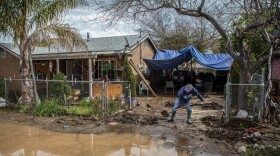
Airport noise complaints — up sharply in the first half of the year — have started to decline, but San Diegans who live under the flight path say it’s not necessarily quieter.
They just don’t think complaining does much good.
The complaints to the San Diego County Regional Airport Authority have jumped more than 600 percent over the past year, with about two thirds coming from the same household. A majority of the more than 30,000 complaints in 2016 are about planes being off path, taking off after Lindbergh Field’s late-night curfew or being too low or too loud.
Melissa Hernholm-Danzo, a member of a community advisory group in Point Loma, told airport officials at a Dec. 21 meeting that after 15 months of submitting noise complaints, she decided she’d rather continue reading to her children at night than get up to send another email.
“You just get tired of doing it,” she said.
Even the most prolific complaint writer is fatigued.
Steve Crow, a Point Loma Heights resident of 10 years, complained about airplane noise far more than anyone else in 2016, filing 20,068 complaints. In February alone, he filed 4,084 complaints, as many as 251 in a day. In November, he lodged 39.
“It really just started two years ago,” Crow said about planes flying over his neighborhood. “But I’ve stopped logging complaints because it wears on you.”
Crow was working from home when he began submitting hundreds of complaints a day. He said he made calls to City Council members and local politicians only to receive a “stock response” each time.
“You’re up against an industry and you’re just residents, that’s all you are,” he said. “You’ve got to dedicate time to something else. Do you move? Yeah, probably. I don’t want to, but there’s just not going to be a resolution.”
An airport authority spokeswoman said an improvement in operations is responsible for the recent downturn in complaints, as well as heightened community awareness of flight paths and daily airport operations.
Explaining the increase
In late 2015, complaints began to rise from several a month to thousands as the Federal Aviation Administration rolled out its plan for the SoCal Metroplex, a project that would alter arrival and departure flight paths at 19 Southern California airports.
For San Diego, the proposal meant departing planes, after taking off toward the west, would turn sooner and fly closer to previously quiet neighborhoods. However, after months of negative feedback from the community, the FAA placed the turning point almost two miles south of the peninsula, farther south than its current location.
Airport authority spokeswoman Rebecca Bloomfield said there were no actual changes in airport operations at the time, and it was the proposal that caused an immediate increase in noise complaints.
Documents provided by the airport authority tell a different story. They show early turns below 6,000 feet and curfew violations, two main causes for noise in Point Loma and nearby neighborhoods, have increased since 2014.
"When they say there was no change, that worries me," said Casey Schnoor, a member of an airport noise subcommittee. “When you look at the data, things were changing."
Early turns occur when air traffic controllers either instruct a pilot to turn before reaching an established waypoint, or approve a pilot's request to do so. The points were created to keep flights on a route straight off the peninsula and around it to avoid unnecessary noise while taking off.
At a November airport noise meeting, FAA officials said controllers allow early turns for three reasons: weather, safety and — most concerning for the committee members — distance between planes, known as separation.
Dr. Lila Schmidt, a physician and Point Loma resident, told FAA officials in November that spacing planes out will cut down on noise, “but you won’t have as much money coming into San Diego.”
She suggested air traffic control — responsible for incoming and outgoing flights on the runway — only permit flights to depart every five minutes, which she said would allow planes to avoid bunching up and would reduce early turns.
In response, Barry Davis, an air traffic manager for the FAA, told her “that will never happen” because passengers will have to wait too long on the runway before taking off.
In a recent report, inewsource found airlines are paying an increasing number of fines for breaking the Airport Authority rule that says planes can’t take off between 11:30 p.m. and 6:30 a.m.
Although fines are higher and more frequent than in previous years, violations have increased from 47 in 2014 to 55 through November of this year.
How the airport authority responds
“There’s only so many things the airport can do,” airport authority spokeswoman Bloomfield said. The takeoff curfew is not an FAA rule.
Bloomfield told inewsource the authority can only make recommendations to the FAA, air traffic control and airlines on issues like early turns and curfew violations. She said once flights are on the runway, the FAA is in charge. Air traffic control directs planes on when to depart and when it is safe to make a turn.
The airport authority can’t stop flights from taking off after 11:30 p.m., but it can levy fines of up to $30,000 if the local rule is broken, Bloomfield said, and airlines have long been aware of the curfew.
To combat community concern over noise, the airport authority recently increased the frequency of airport noise meetings from quarterly to every other month and created a subcommittee allowing the public to communicate directly with FAA officials.
But community members who continue to submit noise complaints say that effort may not be enough.
“Every meeting we get told, ‘We’ll look into it,’” Schmidt said. “I just want to hear, ‘We fixed it.’”






